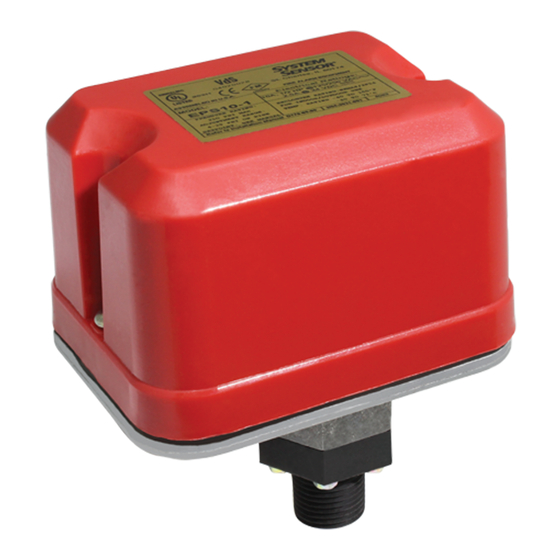Table of Contents
Advertisement
Quick Links
INSTALLATION AND MAINTENANCE INSTRUCTIONS
EPS10 Series Alarm Pressure Switches
SPECIFICATIONS
Contact Ratings:
Overall Dimensions:
Operating Temperature Range:
Maximum Service Pressure:
Maximum Adjustment Range:
Enclosure Rating:
Approximate Differential:
FIGURE 1. PRESSURE SWITCH BASIC DIMENSIONS:
4-1/4"
GROUND
SCREW
(GREEN)
5-1/8"
LOCKING SCREW
IMPORTANT
Please Read Carefully and Save
This instruction manual contains important information about the installation and op-
eration of alarm pressure switches. Purchasers who install switches for use by others
must leave this manual or a copy of it with the user.
Read all instructions carefully before installation, following only those instructions
that apply to the model you are installing.
Before installing any alarm device, be thoroughly familiar with:
Installation, Maintenance, and Use of Protective Signaling Systems
NFPA 72:
NFPA 13:
Installation of Sprinkler Systems
NFPA 13A: Inspection, Testing, and Maintenance of Sprinkler Systems
Other applicable NFPA standards, local codes, and the requirements of the authority
having jurisdiction.
Failure to follow these directions may result in failure of the device to report an alarm
condition. System Sensor is not responsible for devices that have been improperly
installed, tested, or maintained.
Do not use in potentially explosive atmospheres. Do not leave unused wires exposed.
10 A,
1
/
HP @ 125/250 VAC
2
8 A, 125/250 VAC (LPCB only)
2.5A @ 6/12/24 VDC
See Figure 1
–40° to +160°F
300 PSI
4 – 20 PSI
UL 4x — Indoor or Outdoor Use
NEMA 4 — Indoor or Outdoor Use
IP54
3 PSI throughout range
HEX
SWITCH #2
ADJUSTMENT
SCREW
MAIN ADJUSTMENT
WHEEL
1/2" NPT
CAUTION
OPERATION
As pressure changes, a diaphragm actuates 1 or 2 snap action switches. The pressure
switch actuation is determined by adjustment settings.
INSTALLATION
1.
Remove Cover
Cover is held on by two tamper resistant screws. (Removal key is enclosed with
pressure switch.)
2.
Mounting the Switch
The device is designed to be mounted in the upright or horizontal position; side
mounting is also acceptable. Locate it where vibration, shock, and mechanical
loading are minimal. Refer to piping diagram (Figure 2 on page 2).
a. Mount the device directly to the line via the
tion. The use of teflon pipe sealant tape is recommended. Be sure the
fitting is tight enough to prevent leaks.
b. Apply tightening torque to the black plastic hex portion of device.
High voltage. Electrocution hazard. Do not handle live AC wiring or work on a de-
vice to which AC power is applied. Doing so may result in severe injury or death.
When utilizing switches at voltages greater than 74 VDC
, means to provide all-pole disconnection must be incorporated in the field wiring,
such as a circuit breaker.
W0170-00
3.
Wire the device in accordance with the National Electrical Code. Two
diameter conduit connection holes have been provided in the mounting
plate to accept standard
type). If a NEMA 4/UL 4x (waterproof unit) is required, waterproof flex-
ible metallic conduit and appropriate conduit fittings must be used. Recom-
mended connectors are Thomas and Betts PN 5332 (180° coupling), PN
5352 (90° coupling), and PN 5262 seal ring.
4.
Connect wiring to terminals (see Figure 3 and Table 1).
TABLE 1. ELECTRICAL CONNECTIONS
(REFERENCED AT FACTORY SETTINGS):
MODEL EPS10-1
SWITCH AT 0 P.S.I.
B
COM
A
SWITCH AT 4-8 P.S.I. (HIGH TRIP PT.)
B
COM
A
SWITCH 1
1
3825 Ohio Avenue, St. Charles, Illinois 60174
1-800-SENSOR2, FAX: 630-377-6495
www.systemsensor.com
⁄
" NPT pressure connec-
1
2
WARNING
or 49 VAC
1
⁄
" conduit fittings (one is removable knock-out
2
MODEL EPS10-2
SWITCHES AT 0 P.S.I.
B
B
COM
COM
A
A
SW1
SWITCHES AT 4-8 P.S.I. (HIGH TRIP PT.)
B
B
COM
COM
A
A
SW1
BOTH SWITCHES ACTIVATE SIMULTANEOUSLY
7
⁄
"
8
SW2
SW2
I56-0551-011R
04-29
Advertisement
Table of Contents

Subscribe to Our Youtube Channel
Summary of Contents for System Sensor EPS10 Series
- Page 1 SWITCHES AT 0 P.S.I. Failure to follow these directions may result in failure of the device to report an alarm condition. System Sensor is not responsible for devices that have been improperly installed, tested, or maintained. SWITCH AT 4-8 P.S.I. (HIGH TRIP PT.) SWITCHES AT 4-8 P.S.I.
- Page 2 Please refer to insert for the Limitations of Fire Alarm Systems THREE-YEAR LIMITED WARRANTY System Sensor warrants its enclosed pressure switch to be free from defects in materials Drive, Suite 700, El Paso TX 79936, USA. Please include a note describing the malfunc- and workmanship under normal use and service for a period of three years from date of tion and suspected cause of failure.









Need help?
Do you have a question about the EPS10 Series and is the answer not in the manual?
Questions and answers